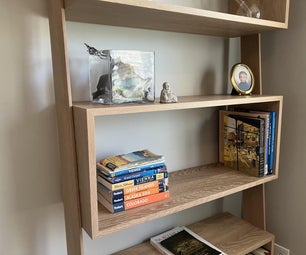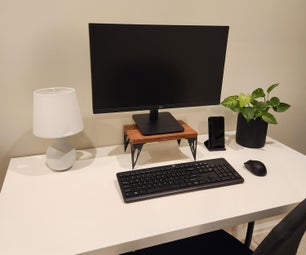Introduction: DIY Rising Table
I saw this beautiful chair from jim_chung, which was inspired by the great designer Robert van Embricqs. You can find his work at www.robertvanembricqs.com. I wanted to rebuilt his rising table on my own. This is my version of the table and I want to share it with you.
I hope you like it and will enjoy the instructions. Have fun :)
Step 1: Marking and Cutting the Wooden Strips
I use 20 wooden strips with 2cmx2cm cross-section and a length of 100cm. This will lead to a round table with a 40cm diameter and a height of approximately 45cm. You can increase the size of the tabletop by adding more strips. The height can increased by using longer strips.
But let's get to work with aligning all 20 strips next to each other. Now I find the middle of the rectangle and draw a circle with the diameter of the 40cm. I use a pencil and a string, because I don't have a compasses, which is big enough.
Now I can draw marks for the cutting on each strip close to the circle. I just need to mark the half of the strips, because there is a symmetry to the horizontal axis and I can cut two strips simultaneously. Make sure to number the strips. I use the numbers 1 to 20. So I can cut 1 and 20, 2 and 19 ... and so on simultaneously. I have to cut each strip into three pieces. Make sure to number all of them.
Step 2: Milling Notches for the Hinges
I bought hinges with the same width as the wooden stripes, in my case 2cm. I want them to fit perfectly on the stripes. Therefore I use my router to cut small notches into the stripes. I mark the area with a pencil and use my router to finish the job...well this will take a while, there are 80 notches to cut :)
Step 3: Glueing the Tabletop
Next step is to glue the tabletop pieces together. Actually you can do this later, but I'll do it now, so the glue can dry and I can continue with the rest in the meanwhile. Well there is not much to say. I use wood glue to glue the pieces and clamps to put a bit pressure on them. Unfortunately I don't have clamps wide enough for all pieces. That's why I glue the tabletop in two steps. Make sure you align all parts to the center line and in the right order.
Step 4: Cutting the Grooves Into the Legs
Now comes the tricky part. I want the legs to be moveable. Therefore I'll use a threaded rod which will go through all legs. All legs, besides the outer ones, need a groove to let the rod slide along. To figure out the the size of the groove, I use tape to mount the outer and the inner legs to the table top and mark the position of the rod while the legs are moved.
I figure out that I would need a groove from 5cm to 24cm (measured from the bottom of each leg). I use my router table to cut all grooves. I use a guidance on each side and a tape mark to get the same grooves on each leg. Remember, do not cut the outer legs.
Wow, that's a lot of saw dust ;D
Step 5: Drilling Holes Into the Outer Legs
I'm almost done with the legs. The outer legs will hold the rod in place. Therefore they need a hole. I use a wood drill to cut the four holes and cut the edges a little bit. Remember to place the hole at the exact same positions where placed the rod one step before for marking the grooves, or otherwise the grooves wouldn't fit anymore.
Step 6: Grinding All Parts
I use a grinder to smoothen the surfaces of the tabletop. I move the numbers of the legs into the notches for the hinges. They can't be seen later on. Now I can smoothen the surfaces of the legs as well.
Step 7: Apply Paint, Oil or Any Other Finish
This step is totally up to you. You can apply any kind of finish to your wood. I decided to use a dark colored stain to protect the surfaces. Make sure that you can still read the numbers on legs.
Step 8: Puzzle Time and Mounting the Hinges
When everything is dry, I can start with my puzzle. The numbers in the notches will help me find the right leg to the right place. I use my Dremel to cut small holes for the screws. Now I can fasten the hinges to the tabletop and the legs.
Step 9: Trimming the Threaded Rods
The rods are a little bit to long. I use tape to mark the right length and use a cutting disc to trim the rods. I use wing nuts and washers to hold the legs in place.
Step 10: Done!
Congratulations, everything is done and you are hopefully a proud owner of a new table :D
I hope you will enjoy building this. Please let me know your experiences and improvements. Please put photos in the comments. :)

Participated in the
Woodworking Contest













